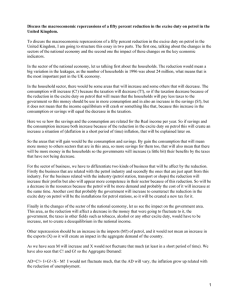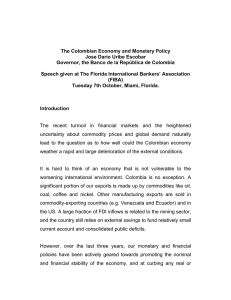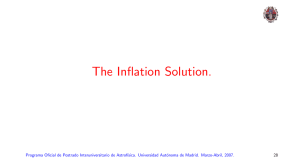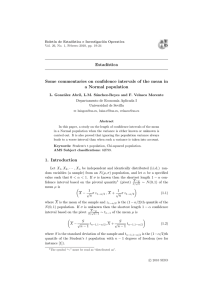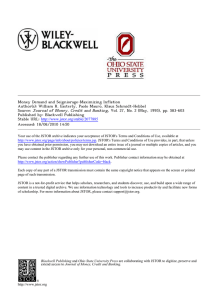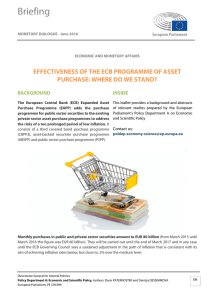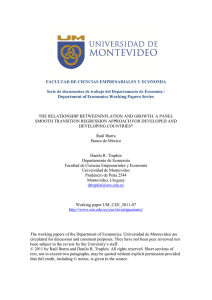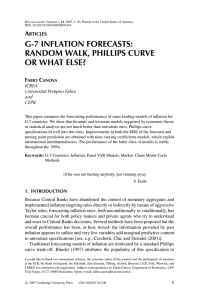On the forecastability and consistency of exchange rate expectations:
Anuncio
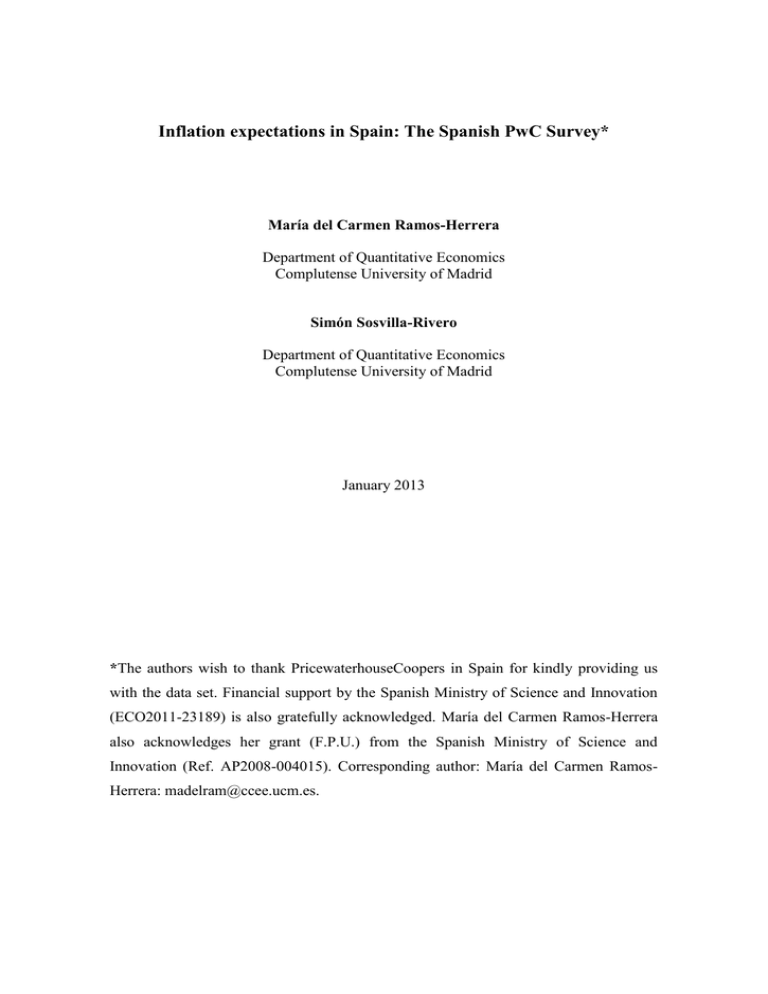
Inflation expectations in Spain: The Spanish PwC Survey* María del Carmen Ramos-Herrera Department of Quantitative Economics Complutense University of Madrid Simón Sosvilla-Rivero Department of Quantitative Economics Complutense University of Madrid January 2013 *The authors wish to thank PricewaterhouseCoopers in Spain for kindly providing us with the data set. Financial support by the Spanish Ministry of Science and Innovation (ECO2011-23189) is also gratefully acknowledged. María del Carmen Ramos-Herrera also acknowledges her grant (F.P.U.) from the Spanish Ministry of Science and Innovation (Ref. AP2008-004015). Corresponding author: María del Carmen RamosHerrera: [email protected]. Abstract: We examine the predictive ability, the consistency properties and the possible driving forces of inflation expectations, using a survey conducted in Spain by PwC among a panel of experts and entrepreneurs. When analysing the headline inflation rate, our results suggest that the PwC panel has some forecasting ability for time horizons from 3 to 9, improving when it comes to predict the core inflation rate. Nevertheless, the results indicate that predictions made by survey participants are neither unbiased nor efficient predictors of future inflation rates, regardless of the measures of inflation used. As for the consistency properties of the inflation expectations formation process, we find that panel members form stabilising expectations in the case of the headline inflation rate, both in the short and in the long-run, although in the case of the core inflation rate, consistency remains indeterminate. Finally, we find that inflation expectations are very persistent and that they appear to incorporate the information content of some macroeconomic variables (current core inflation and growth rate, the USD/EUR exchange rate, the ECB inflation target and changes in the ECB official short-term interest rate). Keywords: Inflation, Forecasting, Expectations, Panel data, Econometric models. JEL classification: E31, D84, C33 2 1. INTRODUCTION Inflation expectations are at the centre of modern macro-economic theory and monetary policy (see, e. g., Gali, 2008, and Sims, 2009). Virtually all macro-economic models are built on the assumption that agents maximize expected utility under a well defined distribution representing their inflation beliefs. In addition, inflation expectations are used by central banks to gain an insight into the private sector’s assessment of the outlook for future inflation and to evaluate perceptions about the credibility of monetary policy1. Despite its prominence and the ample use there is only scarce evidence about how people form their expectations and why they disagree. The basic problem of the expectations approach to forecasting is how to uncover market participants' expectations, since this variable is in fact latent (it cannot be directly observed). Existing measures of inflation expectations may be partitioned into two broad categories depending on whether they are direct or indirect. Indirect measures are inferred from either financial instruments (such as the Treasury Inflation-Protected Security), the term structure of interest rates, or past realizations of inflations rates. Direct methods of measuring expectations typically rely on some sort of survey in which certain subsamples of the population are asked to reveal their personal expectations. Empirical studies often show that inflation forecasts of professional economists influence expectations of those agents who are not experienced in macroeconomic forecasts s (e.g. Carroll 2003; Döepke et al. 2008). Though the rationality of survey forecasts has been debated (Croushore, 1998), they are generally well regarded, especially the forecasts made by the professionals. Indeed, there is some empirical evident suggesting that median responses generally track official estimates of realized inflation, sometimes even outperforming professional forecasters (see, Hafer and Hein, 1985; Thomas, 1999, and Ang et al., 2007, among others). Ang et al. (2007) argue that the superior performance of survey forecasts could be related. to the fact that the 1 Bernanke et al. (2001) discuss how the behaviour of survey forecasts relative to the central bank’s inflation target provides information about credibility. 3 surveys simply aggregate information from many different sources, not captured by a single model. In this paper, we examine the predictive ability and consistency of expectations about the inflation rate based on the quarterly survey conducted by the Spanish branch of PricewaterhouseCoopers (PwC), as well as the possible driving forces behind the expectation formation process. Our sample consists of thirty surveys covering the period from the second quarter of 2003 to the third quarter of 2011. The paper is organised as follows. Section 2 describes the data. In Section 3 the forecast accuracy of the survey is assessed. Section 4 examines the consistency properties of the inflation rate expectation formation process of short and long forecasts. In Section 5 we explore the role of potential determinants in explaining the expectation formation process revealed by the panel. Finally, in Section 6 some concluding remarks are offered. 2. THE SURVEY DATA Since 1999, the Spanish branch of PwC has been conducting a quarterly survey on the Spanish economic situation. One of the questions refers to inflation rate expectations. Survey participants are asked the last week prior to quarter’s end to deliver three and nine- month-ahead expectations or six and twelve- month-ahead expectations of the inflation rate. The dates when the surveys were conducted have been recorded. We have included in the data set the observed, 3-, 6-, 9-, and 12-month ahead inflation rates computing from the overall Consumer Price Index (CPI), taking from the Instituto Nacional de Estadística (INE). The PwC survey is based upon the opinion of panel of experts and entrepreneurs. The panel members cover the following sectors: non-financial corporations (an average of 32.22 percent of respondents), universities and economic research centres (24.26 percent), financial system (21.48 percent), business and professional associations (17.31 percent) and institutions (4.65 percent). The number of participants of the survey varies 4 from 95 in the third quarter of 2009 to 156 in the fourth quarter of 2004, being 118 the average number of participants. One important feature of the Spanish PwC panel is anonymity of forecasters. Although the names of the panel participants are provided for each survey, it is not possible to know the answers of each person, so the researcher cannot follow the forecasts of a particular panel member over time. Nevertheless, this anonymity could encourage people to provide their best forecasts, without fearing the consequences of making forecast errors. We concentrate in the 3-, 6-, 9- and 12-month ahead forecasts, using 30 of the 33 surveys available2. On average, the number of survey participants who responded to our question of interest was 115, reaching its minimum and maximum in the third quarter of 2009 to fourth quarter 2004 with 90 and 154 people, respectively. 3. FORECAST ACCURACY We initially evaluated the forecasting performance of the PwC panel in explaining headline inflation using the root mean square error (RMSE) and the Theil inequality coefficient. Additionally, we also consider the decomposition of the mean squared forecast error in its bias, variance and covariance proportions in order to assess, respectively, how far the mean of the forecast is from the mean of the actual series, how far the variation of the forecast is from the variation of the actual series, and how large is the remaining unsystematic forecasting errors. Panel A in Table 1 shows the forecasting performance of our panel in tracking evolution of the overall CPI for 3-, 6-, 9- and 12-month ahead. As can be seen, the RMSE is large and increases with the forecast horizon what it means that forecasters have made mistakes in their predictions and make it worse as we move away from the temporal horizon. This result is reinforced regarding the Theil inequality coefficient, since it is not closer to zero. As for the bias proportion, since it is always zero, it suggests no 2 We do not have enough information for the question of the inflation rate for the surveys corresponding to the third quarter of 2007, the first quarter of 2008 and finally the third quarter of 2010. 5 systematic error in the forecasts of the PwC panel. The estimated variance proportion indicates a notable ability of the forecasts to replicate the degree of variability in the inflation rate, at least for the horizons k=3 and 6. For these forecasting horizons, the bias and variance proportions are small so that most of the bias is concentrated on the covariance proportions (i.e., in the unsystematic error). In other words, the mistakes made by panel members are not deterministic, in particular, the deviation of inflation rate prediction with respect to the actual value is random. Table 1: Forecast accuracy RMSE 3-month ahead 6-month ahead 9-month ahead 12-month ahead 0.972937 1.054963 1.579039 1.703497 RMSE 3-month ahead 6-month ahead 9-month ahead 12-month ahead 0.565846 0.538645 0.830764 0.903056 Panel A: Headline inflation Theil Bias inequality proportion coefficient 0.166897 0.004262 0.197166 0.063899 0.290485 0.023790 0.310188 0.045373 Panel B: Core inflation Theil Bias inequality proportion coefficient 0.117376 0.015627 0.118828 0.016251 0.183802 0.005659 0.201881 0.017680 Variance proportion Covariance proportion 0.063673 0.011847 0.141639 0.089201 0.932064 0.924255 0.834571 0.865427 Variance proportion Covariance proportion 0.000036 0.000012 0.098943 0.048886 0.984336 0.983737 0.895398 0.933434 To assess if the PwC panel is able to predict more accurately than a random walk the direction of headline inflation movements, we have also computed the percentage of correct predictions. As can be seen in Panel A of Table 2, predictions as to whether the headline inflation rate will increase or decrease for every forecast period, they show nearly 60% of successes for k=3 and 9 and surpassing for k=6, 12.Therefore, panel forecasts clearly outperforming the random walk directional forecasts in all horizons. Table 2: Directional forecast Panel A: Headline inflation 3-month ahead 6-month ahead 9-month ahead 12-month ahead 58.82 61.54 58.82 61.54 Panel B: Core inflation 3-month ahead 6-month ahead 9-month ahead 12-month ahead 82.35 76.92 76.47 76.92 6 Therefore, the evidence presented in Panels A of Tables 1 and 2 suggests that the PwC panel has some forecasting ability in tracking the evolution of the headline inflation in Spain, at least until 9-month ahead. Blinder and Reis (2005) argue that it is better to predict headline inflation using lagged core (rather than headline) inflation. To explore the possibility that the participants in the PwC panel could be paying less attention to headline inflation data but they could be still relying heavily on core inflation data, we have assessed the forecast accuracy and the directional forecast behaviour of the inflation expectations when forecasting core inflation. Panel B in Tables 1 and 2 show the results. As can be seen, there is a general improvement in both the RMSE statistic, the Theil inequality coefficient and in the directional forecasts. Surprisingly, forecasts of headline inflation are rather good forecasts of core inflation. Therefore, our results seem to suggest that the panel participants may be implicitly forecasting the core inflation rate, instead of the headline inflation rate (which is what they are asked to forecast). As a further assessment of the accuracy of the forecasts made by the PwC panel, we test the hypothesis that the panel forecasts are optimal predictors of future inflation rates. If the forecasts made by panel participants are unbiased and efficient predictors of the future inflation rate, a regression of the observed inflation rate at time t+k ( expected rate determined at time t for k-periods ahead ( ) on the ). (1) should result in a estimated constant ( ̂ ) not significantly different from zero and an estimated coefficient on the expected rate ( ˆ ) not significantly different from one. Table 3 presents the estimation results and the Wald test on the joint hypothesis: H 0 : ˆ 0, ˆ 1. Moreover, Grant and Thomas (1999) contend that this hypothesis can be used to verify the existence of “weak form of rationality” since the rational expectations hypothesis does not require the forecasts to be strictly correct in all periods but, instead, requires the forecast errors to be unbiased and uncorrelated with any information in which the forecast is conditioned (see Clements, 2005). 7 ̂ ˆ Prob(Fstatistic) Wald F-test No. of observations ̂ ˆ Prob(Fstatistic) Wald F-test Table 3: Forecast optimality Panel A: Headline inflation 3-month ahead 6-month ahead 9-month ahead 0.612682 1.906420 2.535416 (0.0000) (0.0000) (0.0000) 0.754766 0.299054 0.044489 (0.0000) (0.0000) (0.1611) 0.0000 0.0000 0.161124 86.34462 (0.0000) 1937 744.6454 (0.0000) 1504 454.0752 (0.0000) 1937 Panel B: Core inflation 3-month ahead 6-month ahead 9-month ahead 0.691741 0.700064 1.030993 (0.0000) (0.0000) (0.0000) 0.586298 0.565421 0.429859 (0.0000) (0.0000) (0.0000) 0.0000 0.0000 0.0000 1272.243 (0.0000) 1937 No. of observations Notes: p-values in parenthesis 1104.672 (0.0000) 1504 798.0567 (0.0000) 1937 12-month ahead 3.452318 (0.0000) -0.258337 (0.0000) 0.0000 700.3444 (0.0000) 1504 12-month ahead 1.458905 (0.0000) 0.297322 (0.0000) 0.0000 632.5904 (0.0000) 1504 As can be seen, the results suggest that we can decisively reject the null hypothesis for all forecast horizons, indicating that such forecasts are biased and not efficient predictors of the future inflation rate, regardless the inflation measures (headline or core inflation) used as observed inflation rate. Therefore, our results support a “weak form of rationality” for the PwC panel base-inflation expectations, partially reflecting the degree of sophistication of the models and frameworks used by the Spanish market agents when forming their inflation expectations. 4. EXPECTATION CONSISTENCY According to Froot and Ito (1989), consistency of expectations formed at the same point in time prevails if expectations about inflation rate changes during subsequent shorter time periods and expectations about the inflation rate for the entire time period give the same result. Note that consistency is a necessary condition if expectations are to be 8 rational, but is weaker than rationality since it does not require that the expectation process match the stochastic process generating actual inflation rates. Following Frankel and Froot (1987a, b) and Frenkel and Rülke (2011), we assume that inflation rate forecasters build their expectations by using an extrapolative model which can, in its simplest form, be expressed as a distributed lag function with one lag: ( where and ( ) ( ) (2) ) denote, respectively, the inflation rate at t and the expected inflation rate for t+k of forecaster i at time t. Subscript k denotes the forecast horizon and ε the error term. A positive k indicates that with a slowdown in price growth during the period preceding the time of the forecast leads panel members to expect an opposite effect for the next period. Therefore they will expect that the inflation rate in t+k exceeds t, expectations being in this case stabilising. On the contrary, if k is negative and in the preceding period forecasters observe that the rate at which prices grow is less, then they expect that the inflation rate in t+k is less than t, expectations being in this case destabilising. Note that in our survey data gathers the participants’ expectations at different horizons at the same point of time, being the information set available to the agent the same, therefore allowing us to formally estimate (2) for such forecasting horizons. Table 4 reports the results. As can be seen in Panel A, the short-run k and the long-run k are positive for both time horizons (3 and 9 months and 6 and 12 months), indicating that survey participants form stabilising expectations in the short-run and in the long-run when forecasting headline inflation. This result suggests that we should not reject the null hypothesis that short-run forecasts are consistent with long-run forecasts. As for the forecasting of core inflation, results in Panel B. In this case, the estimated betas do not coincide in sign either in the short or in the long term. Regarding the long term, on the one hand, facing a reduction in the core inflation rate, the PwC panel expects a higher core inflation rate nine months later compared with the current rate (since the estimated 9 beta is positive). On the other hand, if the panel participants observe that the core inflation rate in the month of the survey is lower than that in the previous month, they predict that this reduction will be further strengthened after twelve months, being therefore destabilising expectations. While consistency is indeterminate in the long run, the situation does not change when we focus on the short term. The reason is that facing a reduction in the inflation rate, the PwC panel forms destabilising expectations and, although the estimated beta for k = 3 also appears with a negative sign, it is not statistically significant and, after taking the constant out of the regression, the estimated beta experiences a change of sign, implying stabilising expectations. ̂ ˆ Prob(Fstatistic) No. of observations ̂ ˆ Table 4: Expectation formation processes Panel A: Headline inflation 3-month ahead 9-month ahead 6-month ahead -0.143692 -0.193739 -0.157764 (0.0000) (0.0000) (0.0000) 0.919159 0.758780 0.946908 (0.0000) (0.0000) (0.0000) 0.0000 0.0000 0.0000 1937 1937 1504 12-month ahead -0.250228 (0.0000) 1.325477 (0.0000) 0.0000 1504 Panel B: Core inflation 3-month ahead 9-month ahead 6-month ahead 0.358212 0.274911 0.422821 (0.0000) (0.0000) (0.0000) -0.062959 0.392143 -0.673636 (0.4079) (0.0000) (0.0000) 0.407949 0.0000 0.0000 12-month ahead 0.326668 (0.0000) -0.197418 (0.0376) 0.0000 1937 1504 Prob(Fstatistic) No. of 1937 observations Notes: p-values in parenthesis 1504 5. DETERMINANTS OF THE INFLATION EXPECTATIONS To shed further light on the expectation formation process, in this section we explore the role of some variables as driving factors behind the inflation expectations declared by the PwC panel. In particular, we assess significant of the following potential determinants: the inflation target of the European Central Bank (ECB) (proxied as 2 per cent), nominal exchange rate (USD/EUR), real growth (proxied by the growth rate of the industrial production index), core inflation rate, changes in the ECB official interest 10 rate and lagged inflation expectations. Note that information regarding these variables is always available at the time the expectations are formed. ( ) Table 5: Determinants of the inflation expectations ECB Inflation Target Nominal Exchange Rate Real Growth Core Inflation Rate Changes in ECB Official Interest Rate Lagged Inflation Expectations R-squared Durbin-Watson stat No. of observations 3-month ahead -0.141659 (0.0005) 0.243537 (0.0001) 0.004353 (0.0000) 0.069069 (0.0000) -0.131426 (0.0006) 6-month ahead -0.295901 (0.0000) 0.516912 (0.0000) 0.007969 (0.0000) 0.108148 (0.0000) 0.056819 (0.0815) 9-month ahead -0.132021 (0.0023) 0.270501 (0.0000) 0.004332 (0.0000) 0.073107 (0.0000) -0.113218 (0.0057) 12-month ahead -0.222871 (0.0000) 0.442695 (0.0000) 0.005687 (0.0000) 0.097373 (0.0000) 0.065507 (0.0542) 0.929534 (0.0000) 0.880365 (0.0000) 0.904352 (0.0000) 0.866727 (0.0000) 0.961531 2.033311 0.960168 1.907787 0.931463 2.126202 0.936204 1.924588 1936 1503 1936 1503 As can be seen in Table 5, our results indicate quite a significant persistence of inflation expectations, since the estimated autoregressive coefficients are very high (ranking from 0.8667 to 0.9295). In addition, expectations are positively related to the current core inflation and growth rates and the exchange rate. On the other hand, results also suggest a negative coefficient for ECB inflation target, while the coefficient for the ECB official short-term interest rate is negative for k=3 and 9, and positive for k=9 and 12. Therefore, the PwC panel appears to incorporate the information content of a broad set of macroeconomic variables when forming their inflation expectations. 11 6. CONCLUDING REMARKS Expectations are essential for determining economic outcomes and for policymakers. Survey-based measures of inflation provide point forecasts of inflation expectations at various horizons, covering both the short and medium to longer term. In this paper, we aim to provide a simple investigation of Spanish survey-based inflation expectations. To that end, we have investigated predictive ability and consistency properties of inflation expectations using a survey conducted in Spain by PwC among a panel of experts and entrepreneurs, offering further evidence on the explanatory power of expectations directly observed from survey data. Our results suggest that the PwC panel has some forecasting ability for time horizons from 3 to 9 when tacking future general inflation rate, improving when it comes to predict the core inflation rate. Nevertheless, the results confirm that predictions made by survey participants neither unbiased nor efficient predictors of future inflation rates, regardless of the measures of inflation used. As for the consistency properties of the inflation expectations formation process, we find that panel members form stabilising expectations in the case of the headline inflation rate, both in the short and in the long-run, although in the case of the core inflation rate, consistency remains indeterminate. When considering a set of information variables that are relevant for predicting inflation and are available at the time the expectations are formed, we find that inflation expectations are very persistent and that they are positively related to the current core inflation and the USD/EUR exchange rate, but negatively related to ECB inflation target, while the sign of the coefficient for the ECB official short-term interest rate depends on the forecast horizon. The authors wish to thank PricewaterhouseCoopers in Spain for kindly providing us with the data set. Financial support by the Spanish Ministry of Science and Innovation (ECO2011-23189) is also gratefully acknowledged. María del Carmen Ramos-Herrera 12 also acknowledges her grant (F.P.U.) from the Spanish Ministry of Science and Innovation (Ref. AP2008-004015). REFERENCES: Ang, A., Bekaert, G., and Wei, M., 2007. Do Macro Variables, Asset Markets or Surveys Forecast Inflation Better? Journal of Monetary Economics. 54, 1163-1212. Bernanke, B. Laubach, T., Mishkin, F. and Posen, A., 2001. Inflation Targeting: Lessons from the International Experience, Princeton, NJ: Princeton University Press. Blinder, A.S. and Reis, R., 2005. Understanding the Greenspan Standard, in The Greenspan Era: Lessons for the Future, Economic Symposium, Federal Reserve Bank of Kansas City, 11-96. Carroll C. D., 2003. Macroeconomic Expectations of Households and Professional Forecasters, Quarterly Journal of Economics. 118, 269-298. Clements, M. P., 2005. Evaluating Econometric Forecasts of Economic and Financial Variables, Houndmills, Basingstoke, Hampshire: Palgrave Macmillan. Croushore, D., 1998. Evaluating Inflation Forecasts, Federal Reserve Bank of Philadelphia Working Paper No. 98-14. Döepke, J., Dovern, J., Fritsche, U., and Slacalek, J., 2008. The Dynamics of European Inflation Expectations, The B.E. Journal of Macroeconomics. 8, article 12. Frankel, J. A. and Froot, K. A., 1987a. Using Survey Data to Test Standard Propositions Regarding Exchange Rate Expectations, American Economic Review. 77, 133-153. Frankel, J. A. and Froot, K. A., 1987b. Short-term and Long-term Expectations of the Yen/dollar Exchange Rate: Evidence from Survey Data, Journal of the Japanese and International Economies, 1, 249-274. Frenkel, M. and Rülke, J.-C., 2012. Twisting the Dollar? On the Consistency of Shortrun and Long-run Exchange Rate Expectations, Journal of Forecasting, 31, 596- 616. Froot, K.A. and Ito, T., 1989. On the Consistency of the Short and Long Run Exchange Rate Expectations, Journal of International Money and Finance, 8, 487–510. Gali, J., 2008. Monetary Policy, Inflation and the Business Cycle: An Introduction to the New Keynesian Framework, Princeton, NJ: Princeton University Press. 13 Grant, A. P. and Thomas, L. B., 1999. Inflationary Expectations and Rationality Revisited, Economics Letters, 62, 331–338. Hafer, R.W., and Hein, S.E., 1985. On the Accuracy of Time-series, Interest Rate, and Survey Forecasts of Inflation. The Journal of Business, 58, 377-398. Sims C., 2009. Inflation Expectations, Uncertainty and Monetary Policy, BIS Working Paper No. 275. Thomas, Lloyd B., Jr., 1999. Survey Measures of Expected U.S. Inflation, Journal of Economic Perspectives, 13, 125-144. 14
